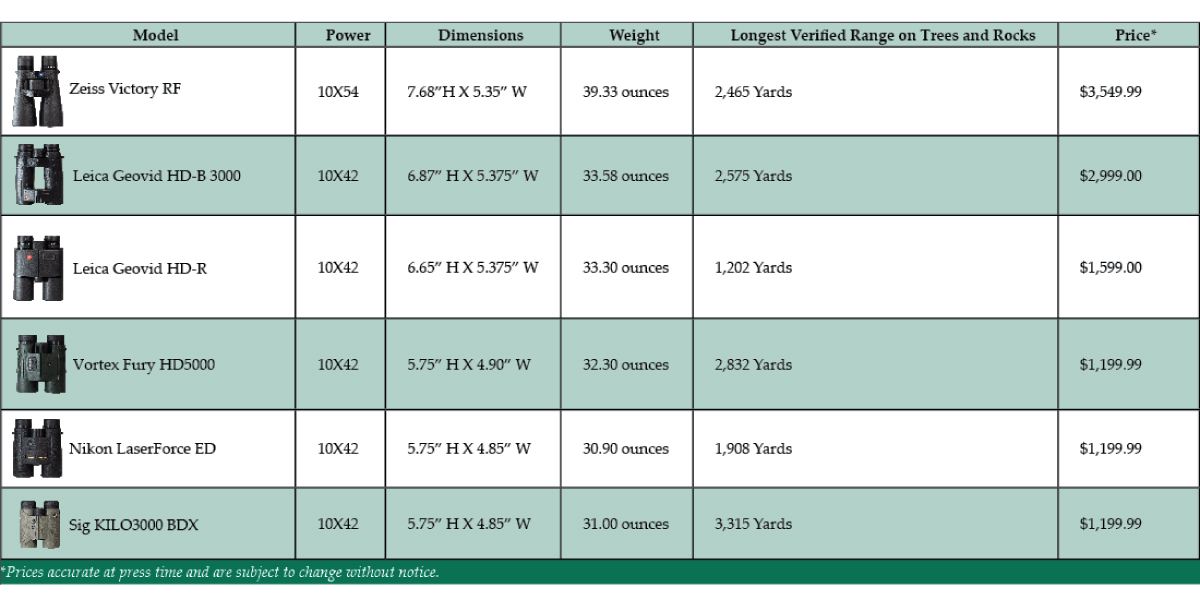By Michael Deming and Staff
Twenty-five years ago, I purchased my first rangefinder. It looked a lot like a Kodak 110 camera which only a few of you reading this will understand what I’m talking about. The concept of turning a dial to make the images come into alignment which provided you a yardage sounds a bit archaic and I wouldn’t even consider it very accurate. It could have also been that my archery equipment was barely breaking the 200 feet per second barrier at the time or maybe it just wasn’t a very refined system. Regardless, you had to practice a bunch and lots of animals got away because the distance to the target was more guess than science.
Fast forward twenty-five years and the rangefinders will generate measurements in yards or meters, adjust for uphill and downhill calculations, gives you wind holds, store all ballistic data, and takes the guesswork out of just about any shot you want to take. To say that they have revolutionized the shooting sports would definitely be an understatement. Putting these ranging devices into a set of binoculars is even better. Being able to have at least a ten-power rangefinder and having the ability to hold it with both hands gives you a very stable platform. This isn’t a new thing as companies have been doing this for a while, but the technology is definitely getting better. It has also gotten more affordable and we here at Sportsman’s News have had most available models in hand and field testing them for the past few months. We wanted to provide real world experience on how far they actually range versus what they have advertised and what to expect from a glassing experience. There is as broad spectrum of pricing here as well and based on that, we aren’t always comparing apples to apples. You will at least get a good idea on what to expect if you are in the market for one of these products. We had multiple people involved in the testing to gain multiple opinions, and not everyone always agrees. Some things are personal preferences, but getting ranges, specifications, and setups were a matter of fact and shown here. When we tested ranges, we went with items like trees and rocks instead of reflective. Every manufacturer touts highly reflective targets, like buildings, signs, or possibly a white target with excessive ranges. I haven’t found many of these things in a real hunting situation where I needed these ranges to make a shot. So, this is real data. Here is our overview on some of the selected models we got to test.
Zeiss Victory RF 10X54- The Victory series is the top of the line for Zeiss which lets everyone know that they brought the very 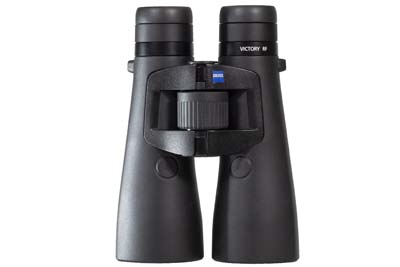 best to the table to give you a high-end optical experience and during our testing they didn’t disappoint. They provide great edge to edge clarity, crisp and clear colors and were at the top of the list in low light performance. They are available in 8x42, 10x42, 8x54, and 10x54, but during our testing we only have the 10x54 version which provided a bigger objective making for better light transmission. We received a test model back in 2018 when they first came out and I carried them during all of the 2018 season and have more experience with them than all the other versions; just to provide full disclosure. The specifications on this model are 7.68” high by 5.35” wide. They tip the scales right at 39.33 ounces, which made them the heaviest. The one thing that should be noted about the initial view of these RF binoculars is that they don’t show any indication of being anything more than just binoculars at first glance. No odd shaped barrels, not overly large, or have protruding buttons which look extremely out of place. They are just a sleek looking set of binoculars.
best to the table to give you a high-end optical experience and during our testing they didn’t disappoint. They provide great edge to edge clarity, crisp and clear colors and were at the top of the list in low light performance. They are available in 8x42, 10x42, 8x54, and 10x54, but during our testing we only have the 10x54 version which provided a bigger objective making for better light transmission. We received a test model back in 2018 when they first came out and I carried them during all of the 2018 season and have more experience with them than all the other versions; just to provide full disclosure. The specifications on this model are 7.68” high by 5.35” wide. They tip the scales right at 39.33 ounces, which made them the heaviest. The one thing that should be noted about the initial view of these RF binoculars is that they don’t show any indication of being anything more than just binoculars at first glance. No odd shaped barrels, not overly large, or have protruding buttons which look extremely out of place. They are just a sleek looking set of binoculars.
 Now let’s discuss what’s under the hood. When you open up the box, it’s very obvious that there is some smart technology and that is the Zeiss Hunting app, which is your platform to unleash the technology of this specific product and is paired via Bluetooth. The rangefinder itself claims being capable of ranging from 11 yards out to 2,500 yards and we assume that 2,500-yard number is on a highly reflective target because our field testing didn’t achieve this high of a number. We have gotten measurements out to 2,465 yards on trees and rocks during our field test. The app provides literally thousands of different ammunition and bullets in its database to match your current shooting system and if you hand-load, you can plug in this data as well. You can have numerous different rifle setups as well as different loads for one rifle and swapping between them is as simple as clicking a few selections and pair the unit with the updates. You have a multitude of choices on what you are able to see in the binocular as well as the order you receive it once you do a range: yardage to target, angle range compensation, as well as MOA correction is my choice based on my current load data. The most important thing to note is that this is corrected data, which means that this unit has taken in the barometric pressure, altitude, angle of shot, and temperature and issued me the corrected data in order to make an extremely accurate shot. One special thing that Zeiss has done that others have not is the placement and adjustability of the rangefinding/set buttons. The ranging button is on the right side and the set button is on the left. They are placed perfectly for me as a right-handed archery hunter at the factory. I don’t need ridiculously long fingers to make things work when I have a bow in one hand and my rangefinding binos in the other. You left-handed bowhunters can have the same benefit, by making a change in the app and swapping sides electronically, you now have the range on the left side and the set on the right. This is a major wow factor for this set of rangefinding binoculars. Currently listed at $3,549.99 on the Sportsman’s Warehouse website makes it a bit steep on the pocketbook, but we feel that it is worth the price based on all it does and the quality of glass.
Now let’s discuss what’s under the hood. When you open up the box, it’s very obvious that there is some smart technology and that is the Zeiss Hunting app, which is your platform to unleash the technology of this specific product and is paired via Bluetooth. The rangefinder itself claims being capable of ranging from 11 yards out to 2,500 yards and we assume that 2,500-yard number is on a highly reflective target because our field testing didn’t achieve this high of a number. We have gotten measurements out to 2,465 yards on trees and rocks during our field test. The app provides literally thousands of different ammunition and bullets in its database to match your current shooting system and if you hand-load, you can plug in this data as well. You can have numerous different rifle setups as well as different loads for one rifle and swapping between them is as simple as clicking a few selections and pair the unit with the updates. You have a multitude of choices on what you are able to see in the binocular as well as the order you receive it once you do a range: yardage to target, angle range compensation, as well as MOA correction is my choice based on my current load data. The most important thing to note is that this is corrected data, which means that this unit has taken in the barometric pressure, altitude, angle of shot, and temperature and issued me the corrected data in order to make an extremely accurate shot. One special thing that Zeiss has done that others have not is the placement and adjustability of the rangefinding/set buttons. The ranging button is on the right side and the set button is on the left. They are placed perfectly for me as a right-handed archery hunter at the factory. I don’t need ridiculously long fingers to make things work when I have a bow in one hand and my rangefinding binos in the other. You left-handed bowhunters can have the same benefit, by making a change in the app and swapping sides electronically, you now have the range on the left side and the set on the right. This is a major wow factor for this set of rangefinding binoculars. Currently listed at $3,549.99 on the Sportsman’s Warehouse website makes it a bit steep on the pocketbook, but we feel that it is worth the price based on all it does and the quality of glass.
Leica Geovid 10X42 HD-B 3000- This product is the top of the line in the Lieca brand as well and performed as such. It comes in 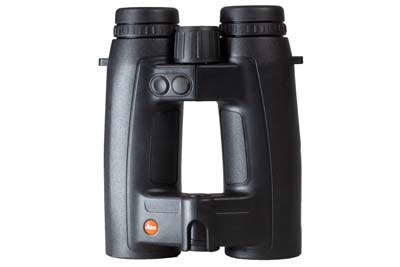 both an 8x42 version and a 10x42, but we only had the 10-power option available to us during the testing. Optically, the clarity and color of the Geovid HD-B 3000 are excellent. Leica has been around for over a hundred years and delivering high quality glass is in their DNA. I feel that you are dealing with a personal preference in brand, history, or customer service when you are comparing top of the line glass like Leica and Zeiss and you are truly splitting hairs to say that one is better than the other. Low light testing was excellent as well and the 42mm objective was almost as good as the Zeiss’ 54mm version.
both an 8x42 version and a 10x42, but we only had the 10-power option available to us during the testing. Optically, the clarity and color of the Geovid HD-B 3000 are excellent. Leica has been around for over a hundred years and delivering high quality glass is in their DNA. I feel that you are dealing with a personal preference in brand, history, or customer service when you are comparing top of the line glass like Leica and Zeiss and you are truly splitting hairs to say that one is better than the other. Low light testing was excellent as well and the 42mm objective was almost as good as the Zeiss’ 54mm version.
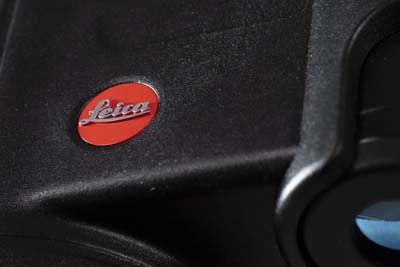 The rangefinding ability of this product is excellent. I utilized this product for numerous years, and it appears that the quality keeps improving. The original version I used was a HD-B 2000-yard rangefinder. Testing this new HD-B 3000 version on a field type of target I was able to get 2,575 yard readings. This unit provides all the needed corrections through the onboard computer to get you complete corrected data for your load. What this means is that it will provide you barometric pressure, temperature, and incline or decline as well as taking into consideration your personal load data to get you a solid shot for distance. There are several ways of inputting your personal load data and one is referred to as a curve in their user manual. This lets you take your current bullet drop and match it to one of similar load data and use what has already been programmed in. This is never usually an exact match and I find this to be okay for ranges out to roughly 600 yards but is inferior out past that range. You have the ability to put your exact load data through the Leica ballistic calculator which is much more accurate and precise to your setup. Once done, it can be transferred onto a micro SD card and put into the rangefinding binoculars. It performed extremely well in all of our testing.
The rangefinding ability of this product is excellent. I utilized this product for numerous years, and it appears that the quality keeps improving. The original version I used was a HD-B 2000-yard rangefinder. Testing this new HD-B 3000 version on a field type of target I was able to get 2,575 yard readings. This unit provides all the needed corrections through the onboard computer to get you complete corrected data for your load. What this means is that it will provide you barometric pressure, temperature, and incline or decline as well as taking into consideration your personal load data to get you a solid shot for distance. There are several ways of inputting your personal load data and one is referred to as a curve in their user manual. This lets you take your current bullet drop and match it to one of similar load data and use what has already been programmed in. This is never usually an exact match and I find this to be okay for ranges out to roughly 600 yards but is inferior out past that range. You have the ability to put your exact load data through the Leica ballistic calculator which is much more accurate and precise to your setup. Once done, it can be transferred onto a micro SD card and put into the rangefinding binoculars. It performed extremely well in all of our testing.
The buttons for both setup and ranging are both on the right side, and I occasionally pushed the wrong button since I don’t use it on a daily basis. This isn’t something that is a problem, but if purchasing, you should be aware. One of the buttons is indented and the other rounded on top, so I’m sure your muscle memory would soon kick in. For those of you left-handed bowhunters, this configuration does provide a problem to hold the bow in your right hand and get ranges, but several models we tested had the same issue. This model is currently listed on the Sportsman’s Warehouse website at $2,999.
Leica Geovid R 10X42 - The HD-R line has been around for quite some time and has been a go to for lots of guides and  outfitters. Probably one of the main reasons is because of the solid Leica brand and customer service history. They are one of the few RF binos that also come in a 15x version. Although I’ve used those in the past, our current test version is the 10x42 model.
outfitters. Probably one of the main reasons is because of the solid Leica brand and customer service history. They are one of the few RF binos that also come in a 15x version. Although I’ve used those in the past, our current test version is the 10x42 model.
Optically, this model is still a Geovid, which means great glass, color, and clarity. It doesn’t appear to have the low light level of brightness that the higher grade of Leica showed, but that shows that you get what you pay for. However, it performed well past legal shooting light and that’s all we are really concerned about.
 The functionality on this model is what we would consider more basic and in line with giving you a great brand and an affordable price. This model is currently listed on the Sportsman’s Warehouse website at $1,599. This unit will give you yardage or meters, but you have to purchase the specific model you want up front and since we are here in the United States, let’s assume that we are working in yards. It advertises that you can get yardage from 10 yards out to 1,200 yards and we exceeded that by a couple of yards (1,202 yards) on several occasions. Once you push the button for range, it will spit out the range to the target and a couple of seconds later, it will give you the angle range adjustment. That’s about the extent of what this rangefinder will do.
The functionality on this model is what we would consider more basic and in line with giving you a great brand and an affordable price. This model is currently listed on the Sportsman’s Warehouse website at $1,599. This unit will give you yardage or meters, but you have to purchase the specific model you want up front and since we are here in the United States, let’s assume that we are working in yards. It advertises that you can get yardage from 10 yards out to 1,200 yards and we exceeded that by a couple of yards (1,202 yards) on several occasions. Once you push the button for range, it will spit out the range to the target and a couple of seconds later, it will give you the angle range adjustment. That’s about the extent of what this rangefinder will do.
The one negative to this model is that the range button is on the top left side of the binocular. It is ideal for the left handed bow hunter but poses a challenge for the right-handers. It is possible because I did it for years, but make sure you are aware when you make this purchase.
Vortex Fury HD 5000 10X42- Vortex has built a brand that says we are going to make a dependable product as well as something 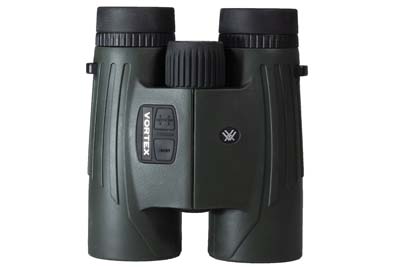 everyone can afford and if anything ever goes wrong with it, we will make it right.
everyone can afford and if anything ever goes wrong with it, we will make it right.
That sums up the Fury HD 5000’s place in the market. It is priced at $1,199.99, which is Sportsman’s Warehouse's current website pricing as of print, making it one of the most affordable laser rangefinding binoculars on the market. I would have liked to see it with the glass and coatings used on the Razor series of binoculars, but that would have driven the price of these up significantly. However, the glass is very good and performed reasonably at low light. I never found a situation that would have cost me an animal during legal shooting light and that’s all I can ask. I did notice that for longer glassing sessions that I’m used to doing that I got a bit more eye fatigue. Vortex claims this unit will range from 5 yards out to 5,000 yards on highly reflective targets 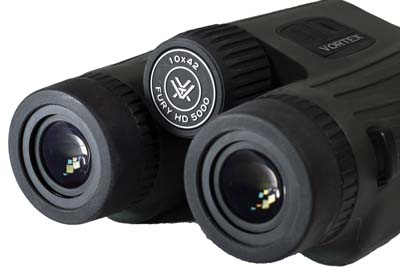 and 5-1,600 on deer-sized targets. Hand holding them, I could consistently and easily get ranges in the 2,300-2,400 range and if I were to put them on a tripod, I could occasionally get a yardage out to 2,700 and the best range ever achieved was 2,832. This is still further than nearly anyone is ever going to shoot and for the money it is a great deal. This unit does have a vast array of menu adjustments as well and these buttons are on the right side of the optics. You can toggle between yards and meters without having to purchase a separate unit. You can also choose Line of Site (LOS) or Horizontal Component Distance (HCD), which adjusts for the uphill or downhill shooting. There are five different brightness settings as well as best and last target mode. This is important when you are shooting at longer ranges and a few yards could mean the difference between a hit or a miss. Overall, they are a great product at a great price and Vortex will always repair or replace them if you have a problem.
and 5-1,600 on deer-sized targets. Hand holding them, I could consistently and easily get ranges in the 2,300-2,400 range and if I were to put them on a tripod, I could occasionally get a yardage out to 2,700 and the best range ever achieved was 2,832. This is still further than nearly anyone is ever going to shoot and for the money it is a great deal. This unit does have a vast array of menu adjustments as well and these buttons are on the right side of the optics. You can toggle between yards and meters without having to purchase a separate unit. You can also choose Line of Site (LOS) or Horizontal Component Distance (HCD), which adjusts for the uphill or downhill shooting. There are five different brightness settings as well as best and last target mode. This is important when you are shooting at longer ranges and a few yards could mean the difference between a hit or a miss. Overall, they are a great product at a great price and Vortex will always repair or replace them if you have a problem.
Nikon LaserForce ED 10X42- The LaserForce ED's have been out for a few years and we have quite a bit of experience in using  them. When we did this test several years ago, they were the best value on the market and at $1,199.99 they are right up there again. The ED glass performs very well and had very little eye fatigue over those long glassing sessions. When looking at long distances for long periods of time, I was able to compare the glass to these on some of the higher-end optics. When it comes to fatigue and staying behind your glass for longer time, this usually equates to more animals found and Nikon delivered here.
them. When we did this test several years ago, they were the best value on the market and at $1,199.99 they are right up there again. The ED glass performs very well and had very little eye fatigue over those long glassing sessions. When looking at long distances for long periods of time, I was able to compare the glass to these on some of the higher-end optics. When it comes to fatigue and staying behind your glass for longer time, this usually equates to more animals found and Nikon delivered here.
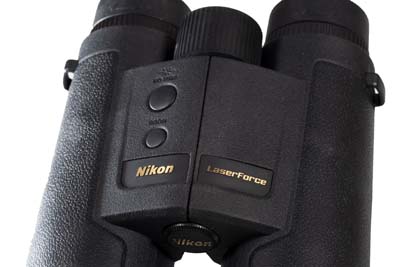 The rangefinding capabilities of this unit is advertised as 10-1,900 yards and Nikon lived up to the promise of “Promise less and deliver more”. I could consistently get 1,900 yards on our field targets by hand holding them and got yardage back quickly. Putting them onto a tripod didn’t achieve much more and the longest yardage I got was 1,908 yards. Being able to get a range quickly and get on target is the name of the game when it comes to harvesting animals.
The rangefinding capabilities of this unit is advertised as 10-1,900 yards and Nikon lived up to the promise of “Promise less and deliver more”. I could consistently get 1,900 yards on our field targets by hand holding them and got yardage back quickly. Putting them onto a tripod didn’t achieve much more and the longest yardage I got was 1,908 yards. Being able to get a range quickly and get on target is the name of the game when it comes to harvesting animals.
The menu on this product is relatively simple and easy to operate as well. You have four different illumination levels, yards or meters, and horizontal distance or actual distance. This makes it very user friendly and easy to operate.
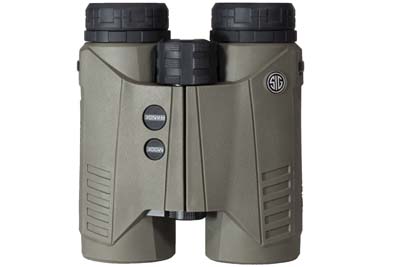 SIG SAUER KILO3000BDX 10X42- SIG isn’t new to rangefinders and some of the top long-range shooters depend on them. In all honesty, I’ve had one in my pocket on every trip since they launched the KILO2400ABS model years ago. This is because of their dependability and ability to range in rain, sleet, snow, or fog and it’s never let me down when other rangefinders have failed in these conditions. They are new to the rangefinding binocular market, but they have taken some good glass and plugged in their already solid rangefinder engines as well as a mobile app to make this an extremely solid competitor in this arena. It provides some of the options only found on the highest end Zeiss in the test, but at a price seen on both the Nikon and Vortex. Currently selling for $1,199.99 at Sportsman’s Warehouse.
SIG SAUER KILO3000BDX 10X42- SIG isn’t new to rangefinders and some of the top long-range shooters depend on them. In all honesty, I’ve had one in my pocket on every trip since they launched the KILO2400ABS model years ago. This is because of their dependability and ability to range in rain, sleet, snow, or fog and it’s never let me down when other rangefinders have failed in these conditions. They are new to the rangefinding binocular market, but they have taken some good glass and plugged in their already solid rangefinder engines as well as a mobile app to make this an extremely solid competitor in this arena. It provides some of the options only found on the highest end Zeiss in the test, but at a price seen on both the Nikon and Vortex. Currently selling for $1,199.99 at Sportsman’s Warehouse.
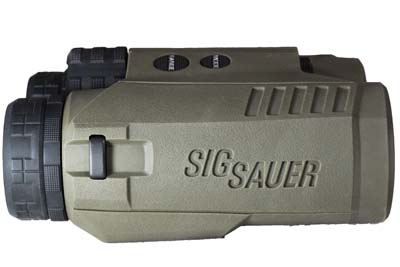 Optically, these binoculars have good glass, but there is room for improvement. Remember, higher quality of glass as well as coatings is going to drive the prices up. This being said, I was able to do long glassing sessions with marginal eye fatigue. They are very clear and looking into the shadows at a mile-plus is what caused the strains. I was able to differentiate antlers from branches and look into those shadows in excess of a mile to do it.
Optically, these binoculars have good glass, but there is room for improvement. Remember, higher quality of glass as well as coatings is going to drive the prices up. This being said, I was able to do long glassing sessions with marginal eye fatigue. They are very clear and looking into the shadows at a mile-plus is what caused the strains. I was able to differentiate antlers from branches and look into those shadows in excess of a mile to do it.
However, the rangefinder and app combination is where this unit really shines. SIG is known for their electronics and they didn’t disappoint here and especially if you pair it with a SIERRA3 rifle scope. The downloadable app gives you the ability to have numerous different rifles or load setups that can be easily transferred back and forth between the app, binos, and scope. This is completely corrected data as well. What that means is that it will take into account all of your input ballistic data, as well as angle, temperature, pressure, etc. All the same things that those really high dollar units do, but this one goes a step further when paired with the rifle scope. Instead of having a turret that needs to be adjusted, this will automatically light up a dot on where to hold. This is accurate out to approximately 800 yards as per their advertised information and we have validated this to that distance on numerous occasions. We did a full video review on the BDX (Ballistic Data Exchange) system in 2018, which is available on our YouTube channel (sportsmansnewstv). This was done with the rangefinder and scope, but it will work with the rangefinding binos as well.
The advertised maximum range on the KILO3000BDX is 5,000 yards on SIG’s website on reflective targets, 2,000 on trees and we were able to achieve 2,800 hand holding the binos and it comes back extremely quickly. Even on a tripod, we didn’t achieve much more and the maximum range ever on these types of targets was 3,315 with this setup.
Testing this equipment was very revealing to see how far this technology has come. Being 51 years old, my eyes aren’t as good as they once were and I still like to shoot long range. The ability to hold my rangefinding binoculars with both hands and having the magnification at 10 power really helped me get a good range on those small targets out past 1,000 yards. Holding a regular rangefinder with one hand and only being 6 or 7 power is very challenging for me and would quickly hinder my ability to be accurate at those longer ranges. Regardless of your budget, there is a rangefinding binocular that will deliver what you need to get on target.
